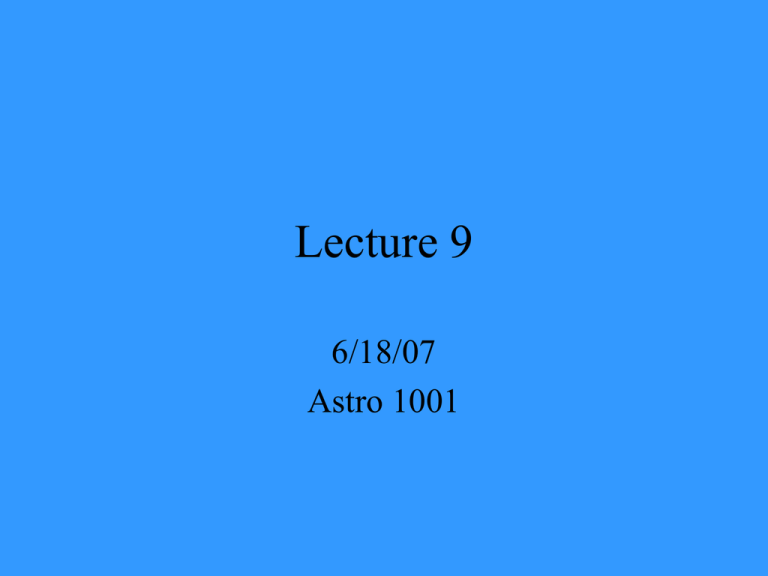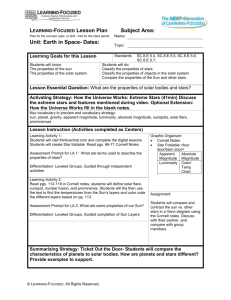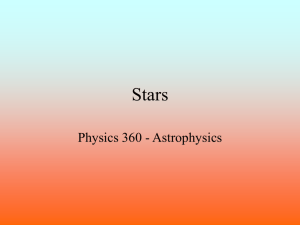Lecture 9
advertisement

Lecture 9 6/18/07 Astro 1001 The Sun • The explanation of how the Sun is giving the Earth so much energy from 150 million kilometers away is very tricky – Chemical burning, gravitational contraction not possible • Nuclear Fusion is the answer – Sun turns mass into thermal energy – Need extreme pressure and temperatures to begin fusion The Stable Sun • Sun is in gravitational equilibrium – Outward pressure balanced by inward gravity • Gravitational contraction allowed the Sun to get started • The Sun has enough fuel to burn for about 10 billion years – Goes through 4 million tons of mass per second Solar Basics • Sun is made out of plasma • Radius is 100x larger than Earth, and its 300,000x the mass of Earth • Sun released 4 x 1026 watts in all directions – Only a small fraction reaches Earth Atmosphere • The Solar Wind is a stream of charged particles blown out from the Sun • Corona extends millions of kilometers away from the visible surface of the Sun • Chromosphere is where temp drops to about 10,000K • Photosphere is the visible surface of the Sun – At about 6,000K – Contains the Sunspots Solar Interior • Convection zone is where convection is occurring – Convection is the reason that the Sun’s surface appears granulated • Radiation zone is where photons carry the energy – Millions of Kelvins • Core has temps of about 15 million Kelvins – Pressure is about 200 billion bars – Only place where nuclear fusion is happening – Energy takes hundreds of thousands of years to reach the surface Alchemy • Changing the number of protons in the nucleus of an atom changes the element • Can split big atoms – Nuclear fission – Powers atomic bombs, nuclear power plants • Can stick together small atoms – Nuclear fusion – Powers hydrogen bombs, Stars Group Work • The Sun generates energy by fusing hydrogen into helium. But, some stars shine by turning heavier elements (like helium) into even heavier elements (possibly oxygen, carbon). Do temperatures need to be higher or lower for the fusion of other elements to occur? Why? • Challenge: Estimate how much higher or lower the temps have to be. Proton-Proton Chain • Two protons fuse to form a nucleus consisting of 1 proton and 1 neutron • Deuterium nuclei collides with a proton to form helium-3 • Another neutron must be added – Probably due to helium-3 collision • Helium-4 nucleus is .7% less massive than 4 hydrogen nuclei Feedback • If nuclear fusion rates varied, so would the Solar temperature – Need a feedback mechanism to keep this in check – Remember the Carbon cycle here on Earth • Rate of nuclear fusion is very sensitive to temperature – Suppose the core temp rose: fusion rate would increase, pressure would push the core apart, make it larger, cooling it down How the Energy Gets Out • Journey of solar energy from core to surface takes hundreds of thousands of years • Photons constantly collide with electrons, get thrown off in a random direction • Eventually, solar temp is low enough so that the plasma absorbs photons, so convection takes over How Do We Know All This? • Mathematical models provide insight • Solar vibrations – Use our friend the Doppler Shift again – Called helioseismology • Solar neutrinos – Lots of them – Inch of lead stops an X-Ray, but lead would have to be a lightyear thick to stop a neutrino Solar Weather • Sunspots are easy to see – Slightly cooler than surface (4000K vs 6000K) – Due to magnetic fields – Sunspots occur where the field lines are knotted – Prevents convection, so not as much energy reach that point – Solar prominences often occur near sunspots More Solar Weather • Magnetic fields are believed to sometimes get so knotted that they snap and rearrange themselves – Leads to solar flares – Magnetic fields are also wiggled by convection, so they give energy to corona – Cause solar wind The Sun and Humans • Coronal Mass Ejections can affect Humans – A large number of charged particles are ejected from the Sun – Reach the Earth in several days – Can cause 100s of millions of dollars of damages Solar Variability • Sunspot Cycle – Number of sunspots gradually rises and falls over 11 years • Reasons for cycle are not understood fully – Thought to occur because the Sun rotates differently at different latitudes – Causes magnetic fields to gradually twist Stellar Luminosities • How bright a star appears depends on its intrinsic brightness and how far away it is – Betelgeuse and Procyon appear equally bright, but Betelgeuse emits 5000x as much energy • Apparent Brightness is how bright a star appears to us here on Earth • Luminosity refers to how much power a star emits into space Parallax (again) • More distant stars have smaller parallax angles • A parsec is a parallax arcsecond – Leads to a simple distance formula Luminosity Range • Lsun represents one solar luminosity • Dimmest stars have luminosities about 1/10,000 that of the Sun • Brightest stars have luminosities 1 million times that of the Sun • Dim stars are a lot more common than bright stars The Magnitude System • Devised by Hipparchus – Brightest stars were first rank, dimmest were 6th rank • Each difference of five magnitudes represents a factor of 100 in brightness • A few objects have magnitudes less than 1 • Absolute magnitude describes stellar luminosities – Its what the stars apparent magnitude would be if it were 10 parsecs away Stellar Temperatures • We measure surface temperatures by looking at the star’s color • Remember that the peak color that something emits depends on its temperature – Red objects are cooler than blue objects • Stars have a spectral type based on their temperature – From hottest to coolest: OBAFGKM – Each category is subdivided into categories (for example, B0, B1, B2…) Stellar Masses • Need to use binary systems so that we can use Newton’s version of Kepler’s 3rd Law • Use Doppler shift to determine the orbital velocity • Use telescopes to determine the greatest separation • Stars have masses from about 150x that of the Sun to about .08x that of the Sun Group Work • Run through the mathematical exercise on page 512, but now Doppler measurements indicate that the orbital speed of the stars are v = 50,000 m/s. What is the mass of the stars? The Hertzsprung-Russell Diagram • Plot surface temperature (backwards!) on the x-axis • Plot luminosity on the y axis Patterns in the HR Diagram • • • • Most stars fall on the main sequence Stars in the upper right are called Supergiants Stars just below that are called Giants Stars near the lower left are small and hot, and are called White Dwarfs • Luminosity classes are used to further clarify things – I are supergiants, III are giants etc The Main Sequence • The Main Sequence is when stars fuse hydrogen into helium in their core • Stellar masses decrease downward along the main sequence • Mass is the most important attribute of a hydrogen burning star The Other Stars • Giants and Supergiants are near the end of their lives – Staving off energy crisis • White dwarfs have run out of fuel – Earth sized – Extremely dense Star Clusters • A cluster of stars is a bunch of stars that formed at the same time and place • Globular clusters – Very dense – Contains millions of stars • Open Clusters – Smaller, closer Age of Clusters • Look for the main sequence turn off







